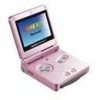Nintendo 1504166 Programming Manual - Page 85
Direct Sounds A and B, Using sound control register SOUNDCNT_H, do a 0 clear with FIFO A and FIFO
 |
View all Nintendo 1504166 manuals
Add to My Manuals
Save this manual to your list of manuals |
Page 85 highlights
AGB Programming Manual Sound 10.2 Direct Sounds A and B Direct sounds have 2 channels, A and B. Linear 8-bit audio data can be played back. The audio data are set to a bias level of 00h and are 8-bit data (+127 to -128), obtained by 2's complement. Audio data are transferred sequentially to the sound FIFO (8-word capacity), using the sound FIFO transfer mode of DMA 1 and 2. The sampling rate can be set to an arbitrary value using timers 0 and 1. Sound FIFO Input Register Address 0A0h 0A4h Register FIFO_A_L FIFO_B_L 15 14 13 12 11 10 09 08 07 06 05 04 03 02 01 00 Attributes Initial Value Sound Data 1 Sound Data 0 W - Address 0A2h 0A6h Register FIFO_A_H FIFO_B_H 15 14 13 12 11 10 Sound Data 3 09 08 07 06 05 04 03 02 Sound Data 2 01 00 Attributes Initial Value W - Sound Data All sounds are PWM modulated (refer to 10.8 "Sound PWM Control") at the final portion of the Sound Circuit. Therefore, if you match the 8 bit audio data sampling frequency and the timer settings with the PWM modulation sampling frequency, a clean sound can be produced. The following operations are repeated for direct sound. Preparing to Use Direct Sound 1. Using sound control register SOUNDCNT_H (refer to 10.7 "Sound Control"), select the timer channel to be used (0 or 1). 2. Using sound control register SOUNDCNT_H, do a 0 clear with FIFO A and FIFO B, and initialize the sequencer. 3. In cases of producing a sound immediately after starting the direct sound, write the first 8 bits of linear audio data to the FIFO with a CPU write. 4. Specify the transfer mode for DMA 1 or 2 (see 12.2 "DMA 1 and 2"). 5. Specify the direct sound outputs settings in the sound control register. 6. Start the timer. ©1999 - 2001 Nintendo of America Inc. 85 D.C.N. AGB-06-0001-002B4















